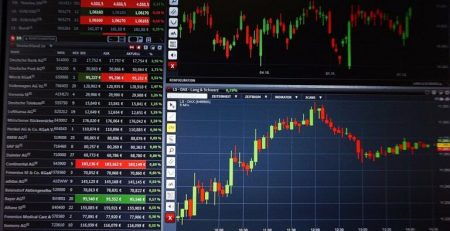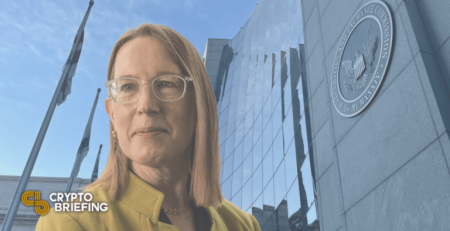Dr. Ryan Clements Warns of Systemic Risks of Terra ($LUNA) Ecosystem
[ad_1]
On Wednesday (April 20), Dr. Ryan Clements, who is an assistant professor at University of Calgary’s Faculty of Law, explained why he remains wary of decentralized algorithmic stablecoin TerraUSD ($USDT) even though it is now partially collateralized by the “forex reserves” (denominated mostly in Bitcoin) of Luna Foundation Guard (LFG).
What Is TerraUSD ($UST) Works and Why It Is (Partially) Backed by Bitcoin
Late last month, Do Kwon — Co-founder and CEO of Terraform Labs, as well as a director at Luna Foundation Guard (LFG) — talked about the Terra protocol in general, and $LUNA and $UST, in particular on episode 335 of journalist Laura Shin’s “Unchained” podcast.
Her is what Kwon said about how $UST works today:
“The idea is that in order to mint TerraUSD (UST), which is a stablecoin pegged to one U.S. dollar, you need to burn a dollar’s worth of $LUNA in order to do so.
“And then on the other side of the trade, If you’re looking to redeem one TerraUSD, you can trade it into the blockchain, and get a dollar’s worth of $LUNA in return. So the idea is that $LUNA, as a staking asset, expands and contracts the supply to absorb the demand volatility for Terra stablecoins.
“We’ve had some pretty good success with this. So, TerraUSD is currently the fourth largest stablecoin in the world at roughly around 16 billion dollars in market cap. And within a relatively recent feature, looking at its current growth trajectory, I think it’s going to be number three relatively soon.
“We recently made announcements whereby we’re bootstrapping a large decentralized forex reserve in the form of Bitcoin. We’ve initially seated this reserve with about 3 billion dollars in assets, and we’re in the process of converting all those exogenous assets into Bitcoin. And then, we have plans to grow this to some meaningful percentage of $UST market cap within the next year.“
He also talked about why $UST is partially collateralized by Bitcoin:
“So, the first phase where $LUNA absorbs demand volatility for the $UST is reasonably robust and as $LUNA market cap grows, is going to get more and more robust, but it also has the downside that in sort of drastic changes in demand, you could lead to death spiral situations, where the price of $LUNA is falling at the same time as the money supply of $UST contracts…
“Similar to how a lot of export based economies in the real world provision forex reserves to sort of control the short-term demand fluctuations in its currency, it became a natural choice for Terra to provision its own forex reserve as well, except in line with what we’re trying to do here, it makes sense to do this in a decentralized fashion by setting a smart contract against which people can trade in Bitcoin to mint more $UST, and vice versa redeem $UST against Bitcoin.“
And here is Kwon talking about how much Bitcoin collateral $UST should have:
“So, for example, if we build that Bitcoin reserves at around like 40%… Here’s what I think about [this].
“The first is I think it’ll take rare events for $UST supply to contract by 40% in a short-term time period. So at a 40% reserve ratio, I feel like we would be collateralizing more than we need to, especially because the core stability mechanism is still good. But what the Bitcoin reserves will play a part in doing is that it would prevent death spirals because it would drastically slow down the pace by which means new $LUNA is being minted to facilitate reductions.
“Second, I think in a long-term arc, we plan to be one of the largest, if not the largest, single-wallet holder of Bitcoin — the Terra protocol itself — and I think over the long arc, the price of Bitcoin is going to do well. So, I think the reserve ratio that we end up with in the long term is going to be a lot higher than the reserve ratio that we paid for at acquisition.“
Why Is Dr. Clements Interested in $UST?
As Chair in Business Law and Regulation at the University of Calgary’s Faculty of Law, Dr. Clements’ academic research interests include “Securities, Financial Market Regulation, Financial Technology (Fintech), Systemic Risk & Financial Crises, Financial Product Innovation, Investment Funds, Crypto-Assets.”
In October 2021, Dr. Clements published a research paper titled “Built to Fail: The Inherent Fragility of Algorithmic Stablecoins”, in which he argued that purely algorithmic stablecoins (i.e. those not backed by any kind of collateral) are inherently fragile:
“… algorithmic stablecoins are fundamentally flawed because they rely on three factors which history has shown to be impossible to control. First, they require a support level of demand for operational stability. Second, they rely on independent actors with market incentives to perform price-stabilizing arbitrage. Finally, they require reliable price information at all times. None of these factors are certain, and all of them have proven to be historically tenuous in the context of financial crises or periods of extreme volatility.“
What Is Dr. Clements Saying About Terra ($LUNA) and Stablecoin TerraUSD ($UST) in April 2022?
On April 20, Dr. Clements was interviewed on CoinDesk TV.
First, he was asked to talk about the relationship between $LUNA and $UST.
Dr. Clements replied:
“When I first started researching and writing in this area, TerraUSD was a purely algorithmic stablecoin, meaning it was a token that purported to maintain a stable peg, and it held that stable peg, similar to other stable coins, without any intrinsic backing or without any assets or without any collatera, but by creating economic incentives to use the stablecoin and creating arbitrage opportunities with another token called $LUNA where as the stablecoin lost its peg — whether it was increasing in value above a dollar or below — there was an opportunity to be able to mint or burn $LUNA, in an arbitrage dynamic to be able to maintain this peg.
“Now, over time, the Luna Foundation Guard in the Terra ecosystem has looked to supplant that or to add to that with a Bitcoin and $AVAX reserve in the event that the economic incentives and the arbitrage mechanism and the supply modifications of this $LUNA-$UST relationship break down. They now have a reserve that they can look to to add to the peg, and so effectively, it’s a different version of a stablecoin that uses economic incentives and arbitrage in order to maintain a stable value.“
Next, he talked about the risks of looking at $UST as money:
“If I look at TerraUSD and I think ‘okay, this is money, this is substitute for money’, I have to be cognisant of what the risks to that money are. With respect to using TerraUSD as a substitute for money, I am susceptible to the risks within the Terra ecosystem, and I’m susceptible to the volatility risk of the reserves and the sufficiency of the reserves that it’s now currently compiling.
“If you look at the Terra ecosystem, two-thirds of the demand for $UST is coming from the Anchor protocol. Lending demand on on the Anchor protocol significantly is higher than borrowing demand on the Anchor protocol. As a result, the Terra Foundation is having to inject reserves to top up depleting reserves on that protocol. So, I look across the Terra ecosystem and I think ‘what are some things that could lead to instability, that could potentially cause this to become de-pegged’, and there’s quite a few.
“There might be another borrowing protocol that’s more popular, that takes liquidity out of Anchor and moves it to another. Staking demand may decrease in Terra, the reserves may not be sufficient to defend the peg. The use cases of Terra may not be utilized… There might be a run on $LUNA…
“My argument is not that it can’t be stable. My argument is that in order for it to be stable there are a number of assumptions that have to hold. We need sufficient demand in this ecosystem. We need this ecosystem to be able to add to the reserves, and I’ll point out that the reserves were not something that that were originally in the ecosystem design; the reserves are something that have come after.
“I look at this, and I think the fact that Terra is adding to these reserves or acknowledging the need for reserves suggest to me that they don’t think the ecosystem in and of itself is sufficient to be able to keep this peg… And so, I look at it, and I think ‘okay, in order to maintain this peg, these assumptions have to hold’, and I think Anchor right now, with a very high APYs on anchor, and the fact that Terra Foundation is having to inject liquidity into Anchor in order to maintain those yields looks vulnerable to me over time.”
Dr. Clements also has other concerns about LFG’s Bitcoin reserves for $UST:
“Even with the Bitcoin reserves, the question will be one of scale. Can the reserves continue to match the market cap of $UST? Because if it can’t, then we rely on this kind of acceptance assumption, that there’s enough use, that there’s enough demand, and there’s enough outside money continually coming in to maintain this and to ward off any de-pegging.
“It’s possible. You know, Matt Levine wrote yesterday where it is possible that you could move from what he described as Ponzi to acceptance to stability. It’s possible. My point is if we’re in that process, we need to be aware, and I actually think that it would be healthy and add some trust to be able to have some more clear disclosures and maybe some operational controls and some stability in this.
“I don’t think we need to look at regulation necessarily as mutually exclusive, but for wanting to use this as a form of money, it could be helpful to have some understanding of where the vulnerabilities are and where the control mechanisms are, and particularly on this concentration side, I think.“
What Nic Carter Says About Algorithmic Stablecoins
Here is how Nic Carter, who is a general partner at Castle Island Ventures, as well as Co-Founder and Chairman of Coin Metrics, expressed his dislike of algorithmic stablecoins on Twitter yesterday:
“of all the bad ideas the crypto industry has come up with algo stables are among the worst…
“no one in their right mind would, given the free choice, hold an algostable with 100x the default risk of USDC/T. unsustainable subsidized yields are not a sufficient long term incentive…
“‘but algostables are decentralized’ — no they’re not. they are all actively managed. they have organizations holding reserves, managing pegs, doing open market operations. insane thing to claim. if you want more decentralized stables then use overcollateralized crypto backed ones…
“and when these things inevitably fail, regulators will use the failure as a stick to bash the rest of the industry with, most likely causing reprisals against useful and functional stablecoins…
“would be nice if the smartest minds of my generation weren’t occupied by developing ever more sophisticated mental gymnastics to justify obvious ponzis“
Disclaimer
The views and opinions expressed by the author, or any people mentioned in this article, are for informational purposes only, and they do not constitute financial, investment, or other advice. Investing in or trading cryptoassets comes with a risk of financial loss.
Image Credit
Featured Image by “petre_barlea” via Pixabay
[ad_2]
Source link












Leave a Reply